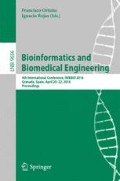Abstract
Genomic medicine pursues to develop methods for improving early diagnosis processes, the efficiency of treatments and facilitating the discovery of new therapies, and mainly searches for associations between the genotype of individuals and their phenotypical features. The huge genomic variability is a major difficulty for developing effective computational methods, since the correlation of a locus and a phenotype does not necessarily mean causality. Hence, methods for genome-based diagnosis need to take into account the complexity of the genomic background and the biological networks involved in the manifestation of phenotypes and disorders.
We describe a method for analysing the variants identified in the genome of human individuals, sequenced using Next-Generation Sequencing techniques, and such analysis is based on the existing knowledge about the genes, pathways and phenotypes. This method is capable of generating quantitative scores at the levels of gene, pathway and phenotype, which represent the degree of functional disorder of the corresponding gene or pathway, and the level of contribution to development of a specific phenotype of the genomic variant. The validation experiments performed with exomes of patients with “Congenital Disorder of Glycosylation, Type IA” (CDG1A) have shown positive results.
Access this chapter
Tax calculation will be finalised at checkout
Purchases are for personal use only
Notes
- 1.
\( Q = - 10\,\,\log_{10} P \); P is the base-calling error probabilities.
References
Offit, K.: Personalized medicine: new genomics, old lessons. Hum. Genet. 130(1), 3–14 (2011)
MacArthur, D., Manolio, T., Dimmock, D., Rehm, H., Shendure, J., Abecasis, G., Adams, D., Altman, R., Antonarakis, S., Ashley, E., Barrett, J., Biesecker, L., Conrad, D., Cooper, G., Cox, N., Daly, M., Gerstein, M., Goldstein, D., Hirschhorn, J., Leal, S., Pennacchio, L., Stamatoyannopoulos, J., Sunyaev, S., Valle, D., Voight, B., Winckler, W., Gunter, C.: Guidelines for investigating causality of sequence variants in human disease. Nature 508(7497), 469–476 (2014)
The 1000 genomes project consortium. http://www.1000genomes.org
Marian, A.: Molecular genetic studies of complex phenotypes. Transl. Res. 159(2), 64–79 (2012)
Myakishev, M., Khripin, Y., Hu, S., Hamer, D.: High-throughput SNP genotyping by allele-specific PCR with universal energy-transfer-labeled primers. Genome Res. 11(1), 163–169 (2001)
Sanger, F., Nicklen, S., Coulson, A.: DNA sequencing with chain-terminating inhibitors. Proc. Natl. Acad. Sci. U.S.A. 74(12), 5463–5467 (1977)
Soon, W., Hariharan, M., Snyder, M.: High-throughput sequencing for biology and medicine. Mol. Syst. Biol. 9, 640–640 (2013)
Genome reference consortium. http://www.ncbi.nlm.nih.gov/projects/genome/assembly/grc
The Ensembl project. http://www.ensembl.org
RefSeqGene. http://www.ncbi.nlm.nih.gov/refseq/rsg
The consensus CDS protein set. http://www.ncbi.nlm.nih.gov/CCDS/CcdsBrowse.cgi
UniProt consortium. http://www.uniprot.org
INTERPRO protein sequence analysis and classification. http://www.ebi.ac.uk/interpro
REACTOME a curated pathway database. http://www.reactome.org
KEGG pathway database. http://www.genome.jp/kegg/pathway.html
Online mendelian inheritance in man. http://www.omim.org
Free access data from orphanet. http://www.orphadata.org
The OBO foundry. http://www.obofoundry.org
Acknowledgments
This work has been supported by the Ministerio de Economía y Competitividad and the FEDER programme through grant TIN2014-53749-C2-2-R2, and by the Ministerio de Educación, Cultura y Deportes through grant FPU14/06303.
Author information
Authors and Affiliations
Corresponding author
Editor information
Editors and Affiliations
Rights and permissions
Copyright information
© 2016 Springer International Publishing Switzerland
About this paper
Cite this paper
Almagro-Hernández, G., García-Sánchez, F., de la Morena-Barrio, M.E., Corral, J., Fernández-Breis, J.T. (2016). Angel: Towards a Multi-level Method for the Analysis of Variants in Individual Genomes. In: Ortuño, F., Rojas, I. (eds) Bioinformatics and Biomedical Engineering. IWBBIO 2016. Lecture Notes in Computer Science(), vol 9656. Springer, Cham. https://doi.org/10.1007/978-3-319-31744-1_5
Download citation
DOI: https://doi.org/10.1007/978-3-319-31744-1_5
Published:
Publisher Name: Springer, Cham
Print ISBN: 978-3-319-31743-4
Online ISBN: 978-3-319-31744-1
eBook Packages: Computer ScienceComputer Science (R0)

